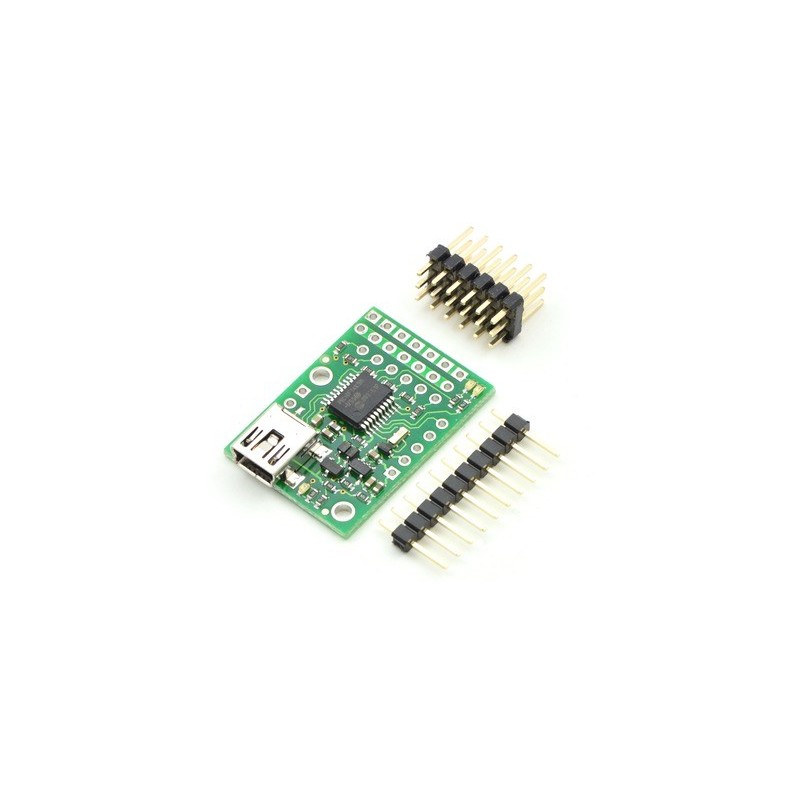



86,89 zł Netto
Pololu Micro Maestro 1351 w wersji kit umożliwia precyzyjne i elastyczne sterowanie serwami oraz czujnikami z poziomu PC lub mikrokontrolera. Dzięki możliwości pracy autonomicznej i wykorzystaniu jako interfejsu USB–TTL, znajduje zastosowanie w systemach sterowania ruchami, projektach animatronicznych oraz układach interaktywnych reagujących na bodźce zewnętrzne.
Micro Maestro 1351 to 6-kanałowy kontroler serwomechanizmów w wersji częściowo zmontowanej – wszystkie elementy SMD są przylutowane, a złącza goldpin dołączone w zestawie wymagają samodzielnego montażu. Umożliwia sterowanie serwomechanizmami z wysoką precyzją (rozdzielczość 0,25 µs) oraz niezależną regulacją prędkości i przyspieszenia dla każdego kanału. Obsługuje trzy tryby sterowania: USB, UART TTL i wewnętrzny skrypt. Kanały mogą pełnić funkcję wyjść PWM, wejść analogowych lub wyjść cyfrowych. Kontroler umożliwia autonomiczną pracę dzięki wbudowanemu interpreterowi skryptów i 1 KB pamięci. Znajduje zastosowanie w robotyce, animatronice i systemach interaktywnych.
Producent BTC Korporacja sp. z o. o. Lwowska 5 05-120 Legionowo Polska sprzedaz@kamami.pl 22 767 36 20
Osoba odpowiedzialna BTC Korporacja sp. z o. o. Lwowska 5 05-120 Legionowo Polska sprzedaz@kamami.pl 22 767 36 20
Kabel z wtykami USB typ A oraz mini-USB typ B, kabel o długości 1,8 m
Brak towaru
Pololu Micro Maestro 1350 to kompaktowy, wszechstronny kontroler serwomechanizmów z interfejsem USB i możliwością pracy autonomicznej, przeznaczony do zastosowań w robotyce, animatronice oraz systemach sterowania opartych na PC lub mikrokontrolerach. Dzięki elastycznej konfiguracji kanałów znajduje zastosowanie również jako interfejs do czujników i ekspander I/O.
Mini Maestro 24 w wersji zlutowanej zapewnia pełną funkcjonalność sterowania 24 serwomechanizmami z możliwością rozbudowy o wejścia analogowe i cyfrowe. Idealny do złożonych aplikacji robotycznych, interaktywnych instalacji i projektów animatronicznych, w których wymagane jest precyzyjne i zautomatyzowane zarządzanie wieloma kanałami.
Brak towaru
Moduł 16-kanałowego sterownika serw z interfejsem I2C oparty o układ PCA9685. modPCA9685
Brak towaru
Moduł z 16-kanałowym generatorem PWM umożliwiający np. kontrolę silników DC, obsługę serwomechanizmów lub sterowanie diodami LED. Magistrala SPI, rozdzielczość sygnału PWM 12 bitów.
BOB-10616
Brak towaru
Sterownik serwomechanizmów do zestawów FPGA TerasIC serii DE umożliwia sterowanie maksymalnie 24 serwomechanizmami. Dostarcza napięcie 6 V do zasilania serwomechanizmów. W zestawie serwomechanizm MG966R i taśma do połączenia z zestawem FPGA. P0288
Kompaktowy moduł umożliwiający wygodne sterowanie serwami komunikującymi się przez UART w trybie half-duplex lub full-duplex, dzięki czemu sprawdza się w zróżnicowanych projektach robotycznych. Wyposażony w złącza Molex oraz dodatkowe piny, pozwala na łatwą integrację popularnych serw, takich jak LX-16A, a także modeli innych producentów. Moduł oferuje wysokoprądowe wyjście zasilania, zapewniając stabilną pracę rozbudowanych systemów z wieloma serwami. Pimoroni PIM697
Moduł do sterowania serwem. Parametry pracy konfigurowane są za pomocą potencjometrów umieszczonych na płytce. SparkFun WIG-13118
Brak towaru
Moduł sterowania serwem o zakresie ruchu 180 stopni, Nie wymaga programowania i jest idealny do operacji takich jak otwieranie i zamykanie ust, dłoni czy oczu. Sterowanie odbywa się za pomocą wbudowanego układu ATTiny13A, przycisku oraz potencjometru, a każdy naciśnięty przycisk przesuwa serwo na drugi koniec zakresu, z możliwością regulacji długości ruchu. Kitronik 2177
Moduł umożliwiający obsługę czterech serwomechanizmów z bezpośrednim zasilaniem w zakresie 5–17 V, co pozwala budować konstrukcje wymagające dużej mocy. Moduł wyposażono w standardowe złącza dla serw oraz dwa wejścia analogowe, które mogą służyć do współpracy z czujnikami lub serwami z informacją zwrotną. Pimoroni PIM695
Zaawansowany sterownik serwomechanizmów z obsługą komunikacji UART i USB, umożliwiający precyzyjne sterowanie wieloma serwami jednocześnie. Kompaktowa konstrukcja i stabilne zasilanie przez złącze śrubowe sprawiają, że urządzenie świetnie nadaje się do integracji w robotach i systemach automatyki o ograniczonej przestrzeni. Współpraca z ekosystemem Seeed Studio XIAO oraz zastosowanie magistrali szeregowej zamiast tradycyjnego PWM zapewniają efektywną, skalowalną i niezawodną kontrolę w projektach edukacyjnych, badawczych i DIY. Seeed Studio 105990190
Sterownik serw w postaci shieldu Arduino. Pozwala sterować 7 serwami z serii Dynamixel AX. Komunikacja odbywa się za pomocą interfejsu SPI. DFRobot DRI0027
Brak towaru
Moduł sterownika serwomechanizmów PCA9685 dedykowany dla minikomputerów Raspberry Pi. Pozwala na sterowanie 16 kanałami PWM. SB Components 08957
Płytka rozszerzeń dla BBC micro:bit, umożliwiająca łatwe podłączenie i sterowanie serwomechanizmami niskiej mocy. Standardowo obsługuje dwa serwa, a po wyłączeniu wbudowanych diod ZIP LED nawet trzy. Zasilana trzema bateriami AAA, jednocześnie dostarcza energii do micro:bit, a włącznik chroni przed niepotrzebnym rozładowaniem. Dzięki pięciu diodom RGB ZIP LED oraz możliwości podłączenia dodatkowych, płytka pozwala na atrakcyjne efekty świetlne i jest idealna do projektów robotycznych, takich jak :MOVE mini. Kitronik 5623
Ten moduł umożliwia rozszerzenie możliwości płytek serii Feather o 8 12-bitowych wyjść PWM, których można użyć np. do sterowania serwami lub diodami LED. Adafruit 2928
Pololu Micro Maestro 1350 to kompaktowy, wszechstronny kontroler serwomechanizmów z interfejsem USB i możliwością pracy autonomicznej, przeznaczony do zastosowań w robotyce, animatronice oraz systemach sterowania opartych na PC lub mikrokontrolerach. Dzięki elastycznej konfiguracji kanałów znajduje zastosowanie również jako interfejs do czujników i ekspander I/O.
Kompaktowy sterownik XIAO Bus Servo Adapter z modułem XIAO ESP32-C3, umożliwiające precyzyjne sterowanie serwomechanizmami ST/SC przez interfejs UART. Dzięki solidnej konstrukcji i zasilaniu 5–12 V pozwala na jednoczesną kontrolę wielu serw, co sprawdza się w robotach humanoidalnych, sześcionożnych i ramionach robotycznych. Wsparcie Arduino IDE, otwarta architektura oraz łatwy montaż czynią go doskonałym narzędziem do edukacji, prototypowania i zaawansowanych projektów robotycznych. Seeed Studio 114993612
Moduł z 16-kanałowym sterownikiem serwomechanizmów PCA9685 przeznaczony dla minikomputerów Raspberry Pi. Płytka wyposażona jest w złącze zasilające USB Typ C. SparkFun DEV-15316

Pololu Micro Maestro 1351 w wersji kit umożliwia precyzyjne i elastyczne sterowanie serwami oraz czujnikami z poziomu PC lub mikrokontrolera. Dzięki możliwości pracy autonomicznej i wykorzystaniu jako interfejsu USB–TTL, znajduje zastosowanie w systemach sterowania ruchami, projektach animatronicznych oraz układach interaktywnych reagujących na bodźce zewnętrzne.
